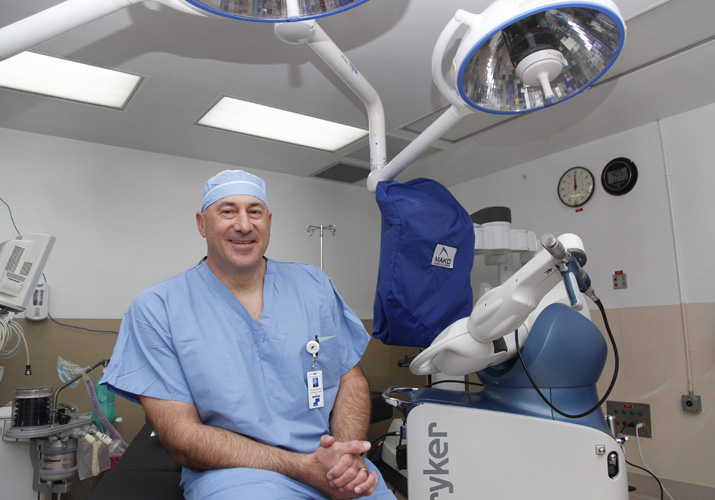
He doesn’t ride around town a horse-drawn buggy like “Doc Adams” from the old TV series “Gunsmoke,” but orthopedic surgeon Dr. Richard Steinfeld is still something of a ‘traveling sawbones.’
Steinfeld, who is with the Orthopaedic Center of Vero Beach, performs surgeries – including partial and total knee replacements as well as hip replacements – at three different locations in and around the Vero Beach area, and when performing these procedures, bones and cartilage do need to be cut and then replaced with artificial components made of metal alloys, high-grade plastics and polymers.
One of the latest means of making those cuts involves the use of a robotic arm-assisted technology platform called “MAKO,” which is manufactured by medical device-maker Stryker.
The Mayo Clinic explains that “computerized tomography (CT) scans are made before the surgery and used to plan exactly how much bone should be removed and to aid in maximizing the accuracy of the alignment and placement of the implant. During the surgery, the MAKO robotic arm ensures that this plan is followed exactly – so that just enough but not too much bone is removed.”
These robotic arm platforms, Mayo continues, “provide tactile, visual and auditory feedback to assist the surgeon in achieving the desired orientation, which can enhance stability and mobility.”
In other words, the MAKO technology provides a patient-specific 3-D model for each procedure. The surgeon guides the Stryker robotic arm based on that plan. This helps the surgeon focus on removal of diseased bone while preserving healthy bone and assists in properly positioning the replacement joint based on the patient’s specific anatomy.
Steinfeld agrees. Sort of.
“I think its greatest asset is probably in total knee replacements,” he says. “It’s a way to quantify what we previously used in terms of feel, right? We learned how to do knee replacements by feeling tissues, by feeling the knee, and now you have an ability to quantify that, and to use those numbers to hopefully be more exacting.”
At the same time, Steinfeld says evaluation of the efficacy of the added cutting precision available with the MAKO system is still lacking one important thing – long-term data.
“The question,” Steinfeld says, “is does that precision make a difference long term [in outcomes] and that’s the $64 million question.”
Asked if he had a $64 million answer, Steinfeld’s responds succinctly: “No. We don’t have 30 years of data look at.”
Pausing briefly, Steinfeld adds, “I mean, look, it’s a knee replacement, which we’ve been doing for 40 or 50 years. The question is can we make them better and more exacting?
“So, that’s going to take a long time to really figure out. I think it’s kind of an exciting option for people. I mean, this is stuff that you’ll see more and more being talked about and written about, but we just don’t have the data yet to know if it makes a true difference” in how successful joint replacement surgeries are by a range of metrics.
Moreover, Steinfeld says, the robotic assistant can prolong the procedure time and increase the need for anesthesia, which are drawbacks. “The longer you’re under an anesthetic, potentially, the risk of infection might go up. So, there’s a plus and a minus like with everything in life.”
And, for the record, the National Institutes of Health says the CT scans used in planning MAKO joint replacement surgeries “subject patients to three times the radiation” they’d receive from a typical radiographic series of X-rays.
Nonetheless, Steinfeld is optimistic and maybe even enthusiastic about MAKO.
He points out “what the robot actually does is not allow you to veer off course and damage tissues around the joint. It has what we call haptic guidance. Once your plan is plugged in, you could push that thing forever and you can’t go past a certain boundary.”
Steinfeld’s suggests that would-be knee or hip replacement patients sit down with their surgeon to discuss their surgical options. They should, at the very least, ask, “Would this technique benefit me? Would it not? Why?”
Those are questions, to Steinfeld’s way of thinking, every patient should ask, and every ‘sawbones’ should be able to answer.
Dr. Richard Steinfeld is with the Orthopaedic Center of Vero Beach at 1285 36th St., Suite 100 in Vero Beach. He performs surgeries there and at the Sebastian River Medical Center in Sebastian and the Grove Place Surgery Center. He can be reached at 772-778-2009.



